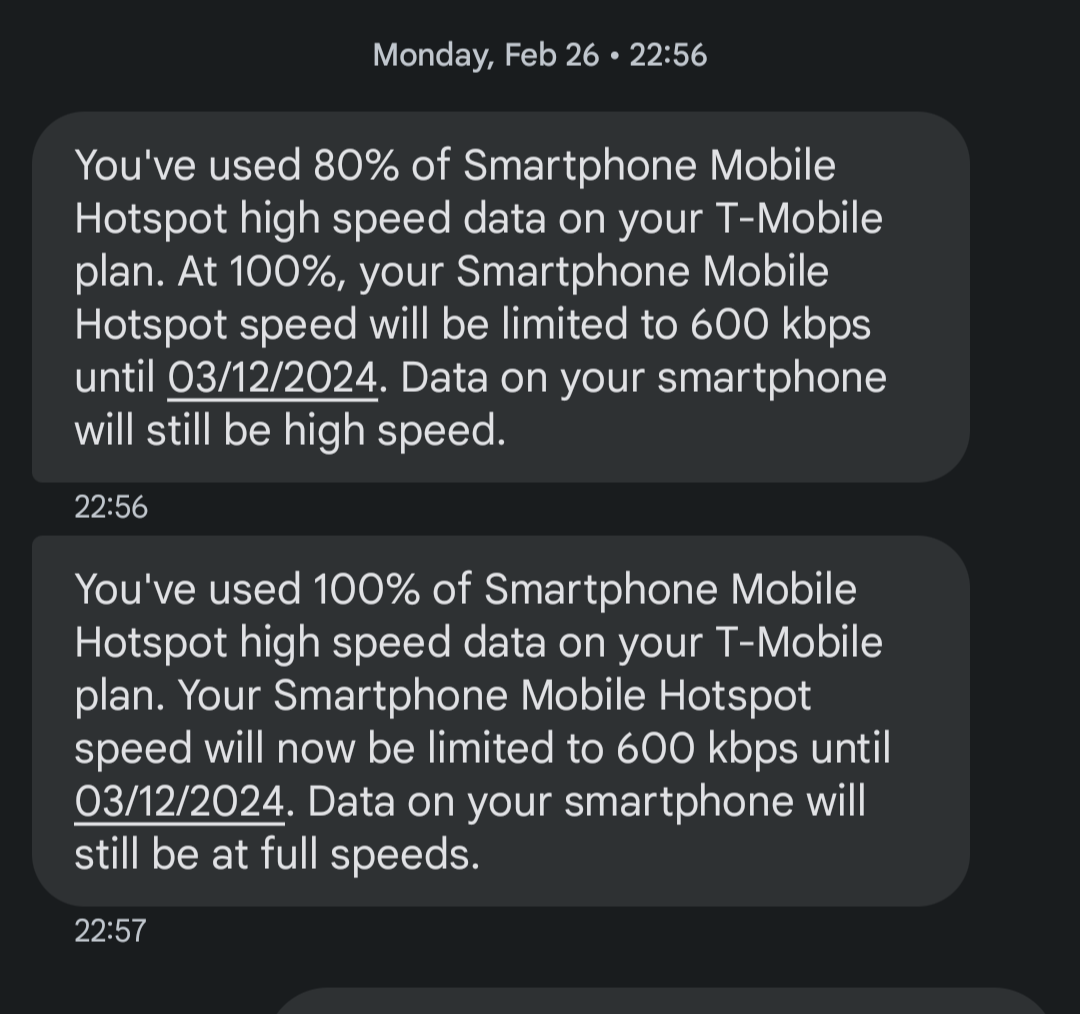What is the difference between cellular data being used on my phone and cellular data being used on my notebook? Data is data.
This is why we need net neutrality
And more competition.
Nationalize the tubes
T-Mobile hasn’t done this for years. Att is just shit
Uh?

When T-Mobile moved to unlimited with the ONE plans, they gave You “unlimited” tethering at “3G speeds”, which turned out to be 0.5Mbit/s, an unusably slow speed in 2018.
The Magenta plans gave you 5GB-50GB of full-speed tethering before dropping you to “3G speeds”. The current Go5G plans are similar, with a limited amount of usable tethering data before you’re, for all practical uses, cut off.
Before the ONE plans, there technically was no hotspot usage limit, but since you had a limited amount of high-speed data, your hotspot was effectively limited to whatever your plan gave you.
All the US carriers limit hotspot usage, partly to prevent someone hooking up a computer to download 50TB of pirated movies while clogging up the bandwidth for everyone else on that tower, and (moreso) partly because they’re greedy.
If it were just bandwidth issues, they’d only limit you during times of congestion.
It’s pure greed.
Lol. They totally do. Their best plan without going arm and a leg for unlimited gives you 50GB a month before dropping to near nothing. Up to a year ago it was 40GB.
This has little to nothing to do with net neutrality, which refers to back end L1 and L2 network interconnections.
That’s not what net neutrality does, and I’m disturbed by this being the number one comment.
Sorry how would net neutrality do anything but make them reword the policy??
The ISP shouldn’t care what kind of traffic is going through the network and show it down by type. It should be neutral to it
They can care about what device they’re providing internet to. Net neutrality is about where content is coming from.
Right… they can still impose data caps. They’ll just do the cap at the plan level, like most already do. OPs just on a cheap plan.
Net neutrality isn’t going to do a thing about this kind of stuff. In a best case scenario, you’ll end up with overall data usage limitations - no more ‘unlimited mobile data’.
ISPs meter data usage because it’s pretty much the only way they can impose some form of limitation on a finite capacity to provide such data to you and other customers - other than data rate limits (read: slower speeds). They can’t guarantee data rates in almost any setup, because ultimately, while ‘data usage’ is a bit of an artificial construct and ‘data’ is not in any way finite, the pipes that deliver the data certainly are of finite capacity. Mobile data capacity - and in fact, any wireless medium - is a shared medium, the more people try to use it simultaneously, the less pleasant it’s going to be for each individual user. Ask Starlink users in many US areas how overselling limited capacity impacts the individual user.
Mobile data usage also has different usage patterns than if you’re hotspotting your PC. You’re not going to download massive games or other bandwidth hogs to your mobile. You probably won’t be running a torrent client either. So they can give you unlimited mobile data because you’re simply not going to put as much of a strain on the infrastructure with pure on-device usage than you will with hotspotting.
This isn’t a defense of what AT&T is doing. But net neutrality isn’t going to force them to suddenly be all ethical. It’s not going to make them provision infrastructure that doesn’t fall over at the first signs of higher-than-usual load. And it certainly can’t change the physical realities of wireless data communication. In an ideal world ISPs wouldn’t be so greedy and/or beholden to greedy shareholders to be cutting corners, and instead provide sufficient infrastructure that can handle high demand.
And to those who are talking about their workarounds: you may not like it but you’ve signed a contract. That contract stipulates acceptable use, and if you’re found to be breaching the contract terms, the other party is within their rights to terminate the contract. Again, in an ideal world these contract terms would be more balanced towards the needs of the customer, but in the meantime your best recourse against unfavourable contract terms is to take your business elsewhere. And if you can’t do that, everything else is at your own risk.
How do they know if the source of data is hotspot? I’d imagine there is a way to stop your phone grassing on you.
There’s different internal network configs (APNs), and hotspot uses a different one than regular mobile data. ( or at least it used to). Those can be configured and metered separately from the carrier’s end.
LineageOS, and maybe some other custom ROMs, wouldn’t do that and would put the hotspot and mobile data on the same APN to get around that.
Can confirm, switching to Graphene solved this problem for me a long while ago.
Doesn’t unlocking the bootloader break Google Pay?
Don’t know, wouldn’t touch that with a 10 foot pole.
What’s wrong with Google Pay?
the Google part
You can lock the bootloader again after the flashing process is done(because it will add the signing key of the new OS), but unfortunately the NFC Payments in Google Pay still won’t work because Google only allows it on ‘certified’ Android systems (aka only the preinstalled OS)
Isn’t this dependent on the ROM, like lineage shouldn’t be locked where as calyx is locked likewise for graphine os
Yes, afaik LineageOS shouldn’t be locked, but I was talking about GrapheneOS specifically because @wesker@lemmy.sdf.org was talking about that.
You can in theory still use Google Pay with a Magisk module called Play Integrity Fix and using a fingerprint from a different phone to pass Basic and Device integrity. I’m currently doing it on my Pixel 7 Pro.
But it has a steep learning curve and is a temporary solution that will disappear in roughly a year once Google sunsets legacy integrity methods and starts requiring Strong integrity, which can’t be faked under known methods. Google is also actively disabling fingerprints that are being spoofed, making the whole thing frustrating and even more temporary even when it works.
Just let us use our devices, sheesh.
Ugh. I was dumb and got a Samsung that was offered to me for cheap on the spot. If I had done any research I would have learned that there’s no alternative OS options. Now I’m stuck with it, because I’m poor, so I just try to avoid using it. I should keep an eye out for something used that’s compatible.
While it’s not at the same level as Graphene OS, Samsung is pretty well supported by Lineage OS. AFAIK at least in Europe Samsung phones have an unlockable bootloader, but YMMV.
I’m still hoping for LineageOS on the Nord N30 but I can’t Even find a stock ROM to root it.
Even on my unlocked, non vendor phone it seems to not recognize hotspot data as different for some reason.
Back when they just began recognizing it, they noted peculiar traffic. Desktop websites, batch downloads normally unavailable to that system. This assumes that you utilized the internal hotspot system and didn’t create a separate one. Now? Not sure whether their system is more robust but it should, theoretically, be possible to obfuscate your traffic using third party hotspot software. No clue where to look for that anymore.
I used to routinely use 100gb of data on my jailbroken sprint iPhone. Did that for almost 3 years. Never heard a peep from them. But this was forever ago.
That was great, and you didn’t have to pay some extra tethering fee every month either (or something like that, it was so long ago for me).
If you used the package I think you did, that’s not unusual. Absolutely will not remember the name but there were numerous tweaks that just flipped the hotspot switch but a couple that allowed you to use a hotspot without directly using the inbuilt function. One was free and broadly used.
TTL in the packet header is 29 instead of 30
Well that’s an easy fix.
If you root your phone and install a custom rom, you can get around it and they can’t tell.
If you’re factory, it sends that hotspot info to them.
You have to turn that feature on.
Could you install a different OS like suggested here https://dubvee.org/comment/1855949 / by Admiral Patrick below?
Yeah, installing a new OS on a phone isn’t something you do easily like on a PC.
You have to unlock the bootloader, which requires an unlock code from the manufacturer, then you have to factory reset it, and that’s even if your phone/carrier allows it. Many don’t (which is why it’s so hard for me to replace my phone…grrr).
So yeah, installing a new OS on your phone is typically going to require quite a bit of effort and some level of commitment as well as a device that’s bootloader unlockable and supported by an alternate OS (each device and model requires a custom build).
It’s…a whole thing. It really shouldn’t be, but it is :(
and that’s even if your phone/carrier allows it.
This is why you should buy the phone outright yourself then get a SIM only deal, rather than paying for your phone in contract.
Yeah I do, but SIM unlocked and bootloader unlockable are two different things. Sadly, not every phone (or even the same phones made for different carriers) are allowed to be bootloader unlocked; I have no idea why, but it is and sucks.
Yeah it’s definitely true, even with the same manufacturer it can be hit and miss. You gotta do your research before you buy.
I haven’t done it in a while, but it kinda depends on the phone, some were very easy to flash in the earlier days of Android.
Yeah, my old Moto Play G4 was a breeze. Wasn’t quite “Press any key to continue” but not much more difficult.
My OnePlus was a little more work, but that was mostly because of the OP website acting up and refusing to generate my bootloader unlock key. Also had to do things differently since it didn’t have an SD card to hold my install stuff like the Moto Play did.
I had one where you could literally run an app on the phone, no ADB or anything. Can’t remember what phone it was now but it might’ve actually been a Moto Droid
One one hand, that sounds extremely convenient. On the other, I shudder thinking what a malicious app could do with that 😆
Edit: Unless you’re talking about doing it through TWRP. I had to flash that over fastboot, but once installed to the recovery partition, I could boot into that and install the rest of Lineage and extra packages straight from the SD card. Updating the system was just downloading the new Lineage .zip to the SD card, booting into TWRP, and clicking install.
Maybe, but it’s not worth it just for a few days, which is all I’ll need it for. I just forked over $15 for another 10 gb.
$15 for 10GB?! USA phone bills are extortionate!
Yeah, it really sucks, but at least there aren’t roaming charges anymore.
Lol when I travel to the US I get 12GB roaming per month included for no extra charge.
You think our phone bills are extortionate? Try Canada. They’re worse. Which is really saying something.
I just have unlimited data in 200 countries on Fi in the US.
It’s worth it for more than a few days, custom ROMs ftw.
Personally my minimum features are:
- Long press back button to force close and kill an app.
- Call recording.
All the other stuff and customisation is just tasty gravy.
This is one of those ‘innovations’ people mean when they say capitalism drives innovation. Not the hotspot, the pointless extra charge for something your phone can just do on its own.
I’ve had great success getting around these restrictions.
CalyxOS + Always on VPN (mullvad)
The secret sauce is using a Android version that allows you to share your VPN with hotspotting. I believe only calyxos and lineage allow you to do this. Since the VPN client is running on the phone, all the traffic that originates from the phone will look like phone data, with the appropriate time to live, OS fingerprinting, etc.
This can’t be done on stock Android, because it does not allow the VPN to be shared over tethering. So tethering traffic will not getting capsulated on the VPN client. There’s a security argument for this, but I prefer the user flexibility of allowing all the traffic to get VPNed.
It’s still possible to do this without VPN sharing on the phone, you can use normal tethering on a unlocked phone, like stock Android. You just have to modify the traffic signature to look like whatever the carrier is looking for. Setting the appropriate time to live, using a VPN, and doing other OS fingerprinting tricks to keep the traffic consistent. It’s much easier to use a ROM that lets you share the VPN
Great tip.
Time to live (TTL) or hop limit is a mechanism which limits the lifespan or lifetime of data in a computer or network. TTL may be implemented as a counter or timestamp attached to or embedded in the data. Once the prescribed event count or timespan has elapsed, data is discarded or revalidated. In computer networking, TTL prevents a data packet from circulating indefinitely. In computing applications, TTL is commonly used to improve the performance and manage the caching of data.
Hmm kinda makes sense
I had a provider before that blocked tethering and hotspot, the solution there was also to increase TTL on the clients connecting to the phone by 1. The phone would lower it by 1 again, making it look like data originated from there.
It’s possible to track the number of hops that a device on a network has, since TTL will be 8-bit numbers (and ususally start at 64, 128, etc.) if the TTL of a packet has 64 from the main device, the devices it’s sharing with will be 63 (and so on un the chain for N+1 hops). This may not be exactly how they do it since device fingerprinting would be way simpler, but it is a plausible way of tracking that a device is using a hotspot.
What is the difference between cellular data being used on my phone and cellular data being used on my notebook?
The difference is the cellular company’s profits amount.
They had this restriction in the UK where the networks would prevent hotspots from actually working. You had to buy a special additional package.
Restriction has now vanished and there are no such limits on usage. Not sure if the Regulator intervened but it was most certainly a cash grab.
These days they still manage to rip us off by annual contract increases of RPI+3.9%. That applies even during a 2 year contract.
Not sure if the Regulator intervened
It was an EU thing before…well you know what you did
I didn’t ask for this. 😭
I think this is also an archaic model from before smart phones and the early days of smart phones. In the early days of apps, most attempted to limit data usage because most network providers charged a premium for data and the networks were much slower and smaller.
While you could tether in these early days, even before smart phones, the computer was capable of much higher data usage than the phone. These limits were put in place to protect a network that wasn’t really built for this level of load.
Old rules with good purpose turned into a way to charge more money.
Which is bullshit. Who cares if you download something at full speed on your phone or through the hotpot? A bit is a bit, doesn’t matter where it ends up when received by the phone’s modem.
It’s a sneaky way of having a bandwidth cap without having a bandwidth cap. Mobile devices have smaller storage, so you’re less likely to use as much bandwidth compared to a laptop. Also a single device going to use less data than multiple devices sharing a hotspot.
Jokes on them, I have a 512GB micrSD card and I use Termux to archive videos through YT-DLP.
Was just going to say… my phone has 512GB storage and can do direct WiFi file transfer to my computer without a hotspot. All without using the mobile hotspot feature.
You can burn through a huge amount of data streaming 4K video on your phone without using any storage. You can also plug a 20TB USB hard drive into your phone, connect to a VPN and torrent away.
But most users don’t. And that’s what they’re counting on.
The carrier who’s paying for your traffic. You’re most likely going to use a lot more data on a computer than actually on your phone.
Unlimited with a limit
You see, this is why we need net neutrality
EDIT: see, im glad someone else said it already
Net neutrality really wouldn’t stop this, just make them reword the limit.
If it’s an android phone, enable dev mode, install adb on your laptop, run an sshd under termux on the phone, and you should be able to set up iptables to forward packets from the laptop through the phone. The phone won’t know that it’s being used for tethering. Although I hadn’t seen the stuff about packet TTL before. Maybe it’s as simple as just adjusting that.
A less complicated method that I used for years:
- Install SimpleSSHD on your phone
- If you’re running Windows, install PuTTY on your PC
- Connect to SimpleSSHD through PuTTY/ssh and set a parameter for dynamic forwarding (CLI option is
-D 8888) - Set your web browser or application to use SOCKS5 proxy at
localhostport8888
It doesn’t redirect all traffic (you’d want to avoid system updates, for example) but might be easier than messing with iptables.
Back in the day PDANet was the app to go to enable unlimited tethering.
Still works for me as of last year. Now I use rooted android with ttlfix.
How can they tell if you are tethering?
Not sure if it’s still the case today, but back then cellular ISPs could tell you are tethering by looking at the TTL (time to live) value of your packets.
Basically, a packet starts with a TTL of 64 usually. After each hop (e.g. from your phone to the ISP’s devices) the TTL is decremented, becoming 63, then 62, and so on. The main purpose of TTL is to prevent packets from lingering in the network forever, by dropping the packet if its TTL reaches zero. Most packets reach their destinations within 20 hops anyway, so a TTL of 64 is plenty enough.
Back to the topic. What happens when the ISP receives a packet with a TTL value less than expected, like 61 instead of 62? It realizes that your packet must have gone through an additional hop, for example when it hopped from your laptop onto your phone, hence the data must be tethered.
This also explains why VPN is a possible workaround to this issue.
Your VPN will encapsulate any packets that your phone will send out inside a new packet (its contents encrypted), and this new packet is the one actually being sent out to the internet. What TTL does this new packet have? You guessed it, 64. From the ISP’s perspective, this packet is no different than any other packets sent directly from your phone.
BUT, not all phones will pass tethered packets to the VPN client – they directly send those out to the internet. Mine does this! In this case, TTL-based tracking will still work. And some phones seem to have other methods to inform the ISP that the data is tethered, in which case the VPN workaround may possibly fail.
You can also just increase your laptop’s initial TTL by one and then they can’t tell.
How do you do this?
That was a good read, thank you
That was a good read, thanks
If you’re using the built-in unmodified hotspot on pretty much all phones these days, mobile data for the hotspot goes through a different apn. Your phone requests data on one channel, while hotspot data goes through another.
They must be sniffing traffic
I’d have a lot of fun trying to get around it. For example, if the phone and the computer were on the same non-Internet-connected wifi network, and you set up an SSH server to send outbound requests through the 4G modem, would they be able to find out you’re using the hotspot?
There are a ton of methods carriers use to detect hotspot traffic, from the device itself handling the categorization, to TTL values attached to requests, to other very clever network sniffing strategies.
Every method I’ve encountered in the past was thwarted by a good ole VPN. This was all on unlocked or rooted phones though so YMMV work carrier phones.
I’d just try to disguise the traffic as coming from something else. Someone further down says just switching to an OS that doesn’t actively snitch does the trick, but if you really wanted you could make your requests look like just about anything, given added volume is free.
max 128kbps
TMobile doesn’t have a hard throttle, but they’ll cut priority under congestion so that if wherever you are has someone else vying for the bandwidth, they get first shot.
Frankly, given that the limited resource is the cell bandwidth, that seems like a more reasonable way to go. It doesn’t hurt them much if someone wants available bandwidth and there’s no contention for it from others.
For hotspot T-Mobile does have a hard throttle. Once you reach your cap you get limited to 128 kbps. It’s only phone data that has the soft cap.
I thought T-Mobile’s throttle was 600kbps now?
It may depend on the plan. Mine limits it to 128 kbps after I reach the 3gb cap for hotspot.
You’ve used 100% of Smartphone Mobile Hotspot high speed data on your T-Mobile plan. Your Smartphone Mobile Hotspot speed will now be limited to 128 kbps until 03/05/2024. Data on your smartphone will still be at full speeds. Buy more at
I can assure you, the multi-million dollar organization does not need your defense of them.
If you use a VPN it can also mask it too. That’s how I used to get around it before moving to Google Fi.
Same, if I have unlimited data it’s none of their business what that data is
Use a VPN. ISP are being disingenuous when they claim a data connection is unlimited at the point of purchase and then slug us with restrictions when we try and use it. If they can detect a tether, the VPN should obscure it.
deleted by creator
Your data is unlimited, the SPEED of the data is not. ;)
That’s like trying to download 1 TB on a dial-up connection. It’ll never be done.
Oh no I can assure you it’ll be done. It’s just so slow that by the time you finish not only will your modern be teetering on the ruckity precipice of death, but you’ll have already upgraded to a neutral modem for direct-to-mind augmented reality. Remember to get an ad blocker and VPN for your cerebrum.





















